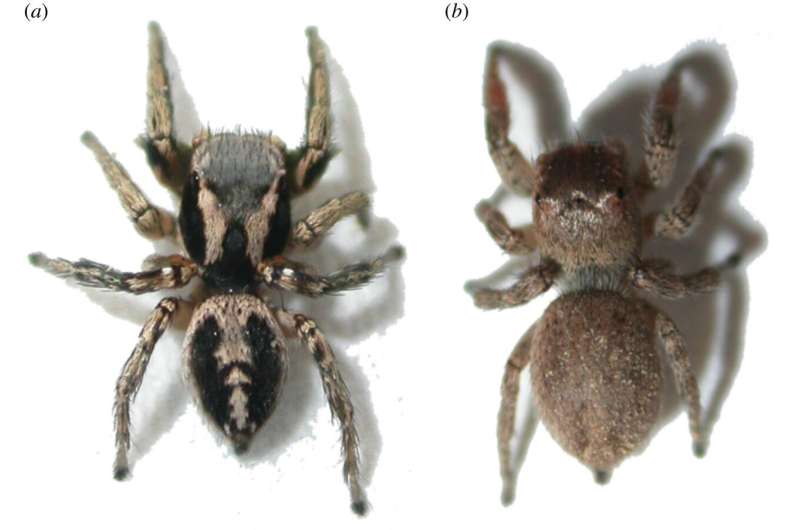
A team of researchers from the University of Florida and Arizona State University has found that removing black stripes on male jumping spiders does not increase their chances of being captured by prey. In their paper published in the journal Royal Society Open Science, the group describes experiments they conducted with jumping spiders.
In one kind of jumping spider (Habronattus pyrrithrix), the male has two black stripes down its back while the female does not. Prior research has suggested that the black lines mimic wasps or other bees as a means of fooling predators. The little spiders have also been seen moving around in ways similar to bees. The female, in contrast, remains still and attempts to blend in to the area around her when predators come near.
In this new effort, the researchers sought to learn more about the little spiders by changing their appearance. They painted several males with makeup to hide their black lines and used different makeup to draw black lines on the backs of females. They then introduced a predator into the mix. Prior to conducting the experiments, the researchers theorized that the predator would not mistake the spiders for bees and would therefore capture and eat more of the males than normal. They did not make any predictions about what would happen with the females.
The predators in the experiments were a much larger kind of jumping spider (Phidippus californicus) and they did not seem at all confused by the painted spiders—they captured and ate the masked males just as readily as they did those with natural stripes on their backs. The researchers did not notice any increase in the predators going after females, either. The end result was that the black lines on the backs of the spiders had no impact on their likelihood of being captured; thus, their purpose is not known. The researchers suggest it is possible that the stripes serve another purpose or that they help protect the male from some other unknown predator. They suggest more research is required to fully understand the reason the males have stripes on their backs.
More information:
Collette Cook et al, Sexually dimorphic dorsal coloration in a jumping spider: testing a potential case of sex-specific mimicry, Royal Society Open Science (2021). DOI: 10.1098/rsos.210308
© 2021 Science X Network
Citation:
Putting makeup on spiders does not change their chances of being eaten by a predator (2021, June 23)
retrieved 23 June 2021
from https://phys.org/news/2021-06-makeup-spiders-chances-eaten-predator.html
This document is subject to copyright. Apart from any fair dealing for the purpose of private study or research, no
part may be reproduced without the written permission. The content is provided for information purposes only.
